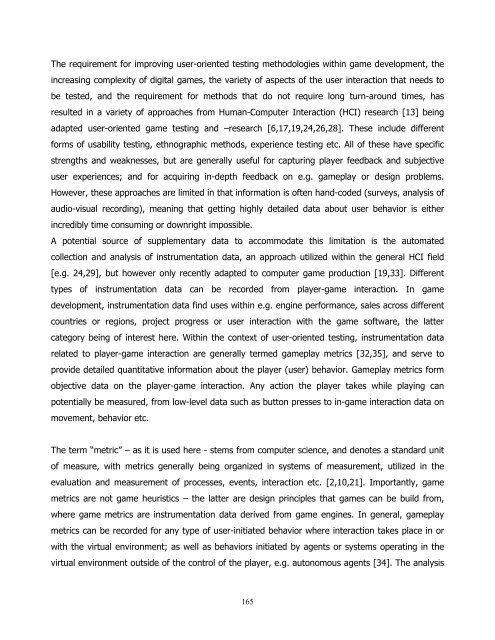Play-Persona: Modeling Player Behaviour in Computer Games
Play-Persona: Modeling Player Behaviour in Computer Games
Play-Persona: Modeling Player Behaviour in Computer Games
Create successful ePaper yourself
Turn your PDF publications into a flip-book with our unique Google optimized e-Paper software.
The requirement for improv<strong>in</strong>g user-oriented test<strong>in</strong>g methodologies with<strong>in</strong> game development, the<br />
<strong>in</strong>creas<strong>in</strong>g complexity of digital games, the variety of aspects of the user <strong>in</strong>teraction that needs to<br />
be tested, and the requirement for methods that do not require long turn-around times, has<br />
resulted <strong>in</strong> a variety of approaches from Human-<strong>Computer</strong> Interaction (HCI) research [13] be<strong>in</strong>g<br />
adapted user-oriented game test<strong>in</strong>g and –research [6,17,19,24,26,28]. These <strong>in</strong>clude different<br />
forms of usability test<strong>in</strong>g, ethnographic methods, experience test<strong>in</strong>g etc. All of these have specific<br />
strengths and weaknesses, but are generally useful for captur<strong>in</strong>g player feedback and subjective<br />
user experiences; and for acquir<strong>in</strong>g <strong>in</strong>-depth feedback on e.g. gameplay or design problems.<br />
However, these approaches are limited <strong>in</strong> that <strong>in</strong>formation is often hand-coded (surveys, analysis of<br />
audio-visual record<strong>in</strong>g), mean<strong>in</strong>g that gett<strong>in</strong>g highly detailed data about user behavior is either<br />
<strong>in</strong>credibly time consum<strong>in</strong>g or downright impossible.<br />
A potential source of supplementary data to accommodate this limitation is the automated<br />
collection and analysis of <strong>in</strong>strumentation data, an approach utilized with<strong>in</strong> the general HCI field<br />
[e.g. 24,29], but however only recently adapted to computer game production [19,33]. Different<br />
types of <strong>in</strong>strumentation data can be recorded from player-game <strong>in</strong>teraction. In game<br />
development, <strong>in</strong>strumentation data f<strong>in</strong>d uses with<strong>in</strong> e.g. eng<strong>in</strong>e performance, sales across different<br />
countries or regions, project progress or user <strong>in</strong>teraction with the game software, the latter<br />
category be<strong>in</strong>g of <strong>in</strong>terest here. With<strong>in</strong> the context of user-oriented test<strong>in</strong>g, <strong>in</strong>strumentation data<br />
related to player-game <strong>in</strong>teraction are generally termed gameplay metrics [32,35], and serve to<br />
provide detailed quantitative <strong>in</strong>formation about the player (user) behavior. Gameplay metrics form<br />
objective data on the player-game <strong>in</strong>teraction. Any action the player takes while play<strong>in</strong>g can<br />
potentially be measured, from low-level data such as button presses to <strong>in</strong>-game <strong>in</strong>teraction data on<br />
movement, behavior etc.<br />
The term “metric” – as it is used here - stems from computer science, and denotes a standard unit<br />
of measure, with metrics generally be<strong>in</strong>g organized <strong>in</strong> systems of measurement, utilized <strong>in</strong> the<br />
evaluation and measurement of processes, events, <strong>in</strong>teraction etc. [2,10,21]. Importantly, game<br />
metrics are not game heuristics – the latter are design pr<strong>in</strong>ciples that games can be build from,<br />
where game metrics are <strong>in</strong>strumentation data derived from game eng<strong>in</strong>es. In general, gameplay<br />
metrics can be recorded for any type of user-<strong>in</strong>itiated behavior where <strong>in</strong>teraction takes place <strong>in</strong> or<br />
with the virtual environment; as well as behaviors <strong>in</strong>itiated by agents or systems operat<strong>in</strong>g <strong>in</strong> the<br />
virtual environment outside of the control of the player, e.g. autonomous agents [34]. The analysis<br />
165















